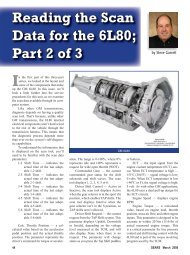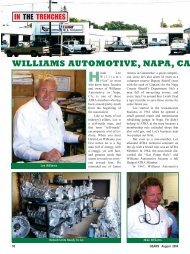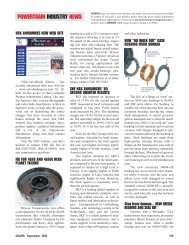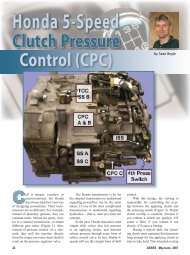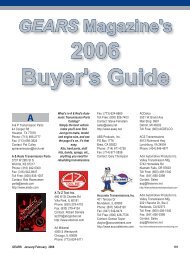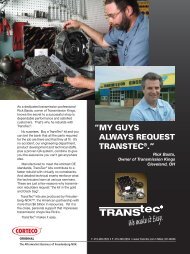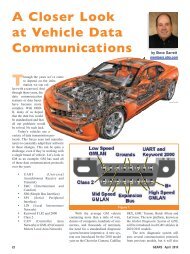Troubleshooting the Toyota A/T Temperature Light - ATRA
Troubleshooting the Toyota A/T Temperature Light - ATRA
Troubleshooting the Toyota A/T Temperature Light - ATRA
Create successful ePaper yourself
Turn your PDF publications into a flip-book with our unique Google optimized e-Paper software.
<strong>Troubleshooting</strong><br />
<strong>the</strong> <strong>Toyota</strong> A/T<br />
<strong>Temperature</strong> <strong>Light</strong><br />
PCM<br />
Most modern vehicles include<br />
special features which are<br />
supposed to enhance <strong>the</strong><br />
driver’s experience, sense of security<br />
or enjoyment behind <strong>the</strong> wheel. When<br />
something like an automatic transmission<br />
goes bad, transmission professionals<br />
like us get involved. Typically <strong>the</strong><br />
work we do turns a customer’s frown<br />
into a smile again.<br />
The purpose of this article is to help<br />
you solve one problem that happens<br />
on <strong>Toyota</strong> 4WD trucks and 4Runners.<br />
These vehicles have an A/T warning<br />
light system. If ei<strong>the</strong>r <strong>the</strong> transmission<br />
or <strong>the</strong> transfer case fluid gets too<br />
hot, <strong>the</strong> warning light comes on and<br />
TH01<br />
TH02<br />
Figure 1<br />
Transmission<br />
<strong>Temperature</strong><br />
Sensor<br />
Transfer case<br />
<strong>Temperature</strong><br />
Sensor<br />
stays lit until <strong>the</strong> fluid cools down.<br />
Unfortunately, <strong>the</strong> warning system isn’t<br />
fool proof: Several <strong>ATRA</strong> members<br />
have reported that after overhaul, <strong>the</strong><br />
warning light is on, even after <strong>the</strong>y<br />
verified <strong>the</strong> transmission and transfer<br />
case fluids were operating at normal<br />
temperatures.<br />
Usually when this type of problem<br />
happens you go right to your repair<br />
database for troubleshooting information.<br />
Unfortunately, all you may find is<br />
a wiring diagram… and a poor one at<br />
that. The next thing you might check is<br />
a factory shop manual. Usually factory<br />
manuals give you enough information<br />
to solve <strong>the</strong> most difficult electrical<br />
by Dave Skora<br />
problems… but not<br />
this time. The <strong>Toyota</strong><br />
shop manual barely<br />
mentions <strong>the</strong> system,<br />
let alone how to fix<br />
it. So what’s <strong>the</strong> plan<br />
of action? You could<br />
just take <strong>the</strong> bulb out,<br />
but that’s probably<br />
not <strong>the</strong> best choice.<br />
Here’s <strong>the</strong> right way:<br />
First a little<br />
background is needed<br />
of how <strong>the</strong> system<br />
is supposed to work.<br />
If <strong>the</strong> transmission<br />
fluid goes over 284º<br />
F or <strong>the</strong> transfer case<br />
fluid reaches 275º F,<br />
<strong>the</strong> A/T warning light<br />
will come on. The<br />
warning light stays<br />
on until <strong>the</strong> temperature<br />
cools back down<br />
by 30-40º F.<br />
The tricky thing<br />
about this warning system is that <strong>the</strong>re<br />
are two sensors. One is in <strong>the</strong> transmission;<br />
<strong>the</strong> o<strong>the</strong>r in <strong>the</strong> transfer case.<br />
To light <strong>the</strong> warning light on 1989-<br />
95 models, <strong>the</strong> PCM grounds <strong>the</strong> circuit<br />
when <strong>the</strong> transmission or transfer case<br />
fluid gets too hot (figure 1). 1986-88<br />
models are similar except <strong>the</strong>y also<br />
have a separate A/T warning light module<br />
(figure 2). This module is connected<br />
to a temperature sensor in <strong>the</strong> transfer<br />
case. If <strong>the</strong> transfer case temperature<br />
gets too hot, <strong>the</strong> A/T warning light<br />
module also lights <strong>the</strong> A/T warning<br />
light by grounding <strong>the</strong> circuit.<br />
A/T Warning<br />
<strong>Light</strong><br />
GEARS April 2006 35
<strong>Troubleshooting</strong> <strong>the</strong> <strong>Toyota</strong> A/T <strong>Temperature</strong> <strong>Light</strong><br />
TCM<br />
A/T<br />
Warning<br />
<strong>Light</strong><br />
Module<br />
Oil<br />
2<br />
1<br />
3<br />
4<br />
5<br />
B+<br />
1986-88 Truck or<br />
4Runner<br />
If <strong>the</strong> A/T warning light continues<br />
to stay on, locate <strong>the</strong> transfer case<br />
module on <strong>the</strong> steering column support.<br />
Disconnect <strong>the</strong> 5-wire connector. If <strong>the</strong><br />
light goes out, it indicates a transfer<br />
case problem:<br />
• <strong>the</strong> transfer case fluid is too<br />
hot…<br />
• <strong>the</strong> transfer case temperature<br />
sensor is bad, or…<br />
Transmission<br />
<strong>Temperature</strong><br />
Sensor<br />
Transfer Case<br />
<strong>Temperature</strong><br />
Sensor<br />
A/T Warning <strong>Light</strong><br />
Figure 2<br />
• <strong>the</strong> A/T Warning <strong>Light</strong> Module<br />
is bad.<br />
To check <strong>the</strong> sensor and circuits,<br />
see <strong>the</strong> A/T Warning <strong>Light</strong> Module pin<br />
chart (figure 3).<br />
If <strong>the</strong> A/T warning light stays on,<br />
turn <strong>the</strong> ignition off. Disconnect <strong>the</strong><br />
TCM located at <strong>the</strong> right kick panel.<br />
Then turn <strong>the</strong> ignition back on. If <strong>the</strong><br />
A/T warning light goes out now, it indicates<br />
a transmission problem:<br />
• <strong>the</strong> transmission fluid is too<br />
hot…<br />
A/T Warning<br />
<strong>Light</strong> Module<br />
Oil<br />
TCM Connector View<br />
• <strong>the</strong> transmission temperature<br />
sensor is bad, or…<br />
• <strong>the</strong> TCM is faulty.<br />
If <strong>the</strong> A/T warning light is still on<br />
with both A/T warning light module<br />
and TCM disconnected, <strong>the</strong> warning<br />
light circuit is shorted to ground. Look<br />
for a short in <strong>the</strong> yellow/red wires<br />
between <strong>the</strong> rear instrument panel connector<br />
and ei<strong>the</strong>r terminal 1 of <strong>the</strong> A/T<br />
Warning <strong>Light</strong> Module or terminal OIL<br />
of <strong>the</strong> TCM.<br />
A/T Warning <strong>Light</strong> Module Pin Chart<br />
Pin Function Condition Voltage or Resistance<br />
1 Warning <strong>Light</strong><br />
<strong>Light</strong> Off<br />
<strong>Light</strong> On<br />
12 Volts<br />
< 0.10 Volts<br />
2 Ignition Key On 12 Volts<br />
3 Transfer Case Sensor<br />
Resistance between pins 3 5-20K ohms @ 68°F<br />
4 Transfer Case Sensor<br />
& 4<br />
540-690 ohms @ 248°F<br />
5 Ground Always < 0.10 Volts<br />
Figure 3<br />
Side<br />
View<br />
Transmission <strong>Temperature</strong> Sensor Transfer Case <strong>Temperature</strong> Sensor<br />
Figure 4<br />
36 GEARS April 2006
In case you haven’t found <strong>the</strong><br />
problem, let’s solve it from <strong>the</strong> o<strong>the</strong>r<br />
direction.<br />
• Turn <strong>the</strong> ignition off.<br />
• Disconnect both <strong>the</strong> TCM and<br />
A/T Warning <strong>Light</strong> Module.<br />
• Turn <strong>the</strong> ignition on.<br />
The A/T warning light should be<br />
off. If it’s still on, fix <strong>the</strong> short to<br />
ground in <strong>the</strong> yellow/red wire between<br />
<strong>the</strong> instrument panel and ei<strong>the</strong>r <strong>the</strong> OIL<br />
terminal of <strong>the</strong> TCM or terminal 1 of<br />
<strong>the</strong> A/T Warning <strong>Light</strong> module.<br />
Assuming <strong>the</strong> A/T warning light is<br />
off with both modules disconnected:<br />
• Turn <strong>the</strong> ignition off.<br />
• Reconnect <strong>the</strong> TCM.<br />
• Turn <strong>the</strong> ignition on.<br />
If <strong>the</strong> A/T warning light is on,<br />
check <strong>the</strong> transmission temperature<br />
sensor and circuit. See <strong>the</strong> A/T Warning<br />
<strong>Light</strong> Module pin chart. If you don’t<br />
find any problems, replace <strong>the</strong> TCM.<br />
If <strong>the</strong> A/T warning light comes on<br />
with <strong>the</strong> A/T Warning <strong>Light</strong> module<br />
connected, check <strong>the</strong> transfer case temperature<br />
sensor and circuit. See <strong>the</strong> A/T<br />
Warning <strong>Light</strong> Module pin chart. If you<br />
don’t find any problems, replace <strong>the</strong><br />
A/T Warning <strong>Light</strong> Module.<br />
1989-95 Truck or<br />
4Runner<br />
If <strong>the</strong> A/T warning light is on, turn<br />
<strong>the</strong> ignition off, disconnect <strong>the</strong> PCM,<br />
and <strong>the</strong>n turn <strong>the</strong> ignition back on. If<br />
<strong>the</strong> A/T warning light is on, repair <strong>the</strong><br />
short in <strong>the</strong> wire between <strong>the</strong> warning<br />
light bulb and <strong>the</strong> PCM.<br />
If <strong>the</strong> A/T warning light is off,<br />
measure <strong>the</strong> resistance across <strong>the</strong> terminals<br />
at <strong>the</strong> PCM for <strong>the</strong> transmission<br />
temperature sensor (Pin THO1 to<br />
ground) and <strong>the</strong> transfer case sensor<br />
(Pin THO2 to ground) (figure 4). The<br />
sensor resistance should be 5-20 ohms<br />
at 68° and 540-690 ohms at 248° F.<br />
Check <strong>the</strong> circuit or sensor if <strong>the</strong> resistance<br />
is incorrect. If <strong>the</strong> resistance is<br />
correct, <strong>the</strong> PCM maybe faulty.<br />
As with so many circuits, <strong>the</strong> A/T<br />
warning light is a fairly simple system<br />
to diagnose and repair, once you know<br />
how it’s supposed to work.<br />
����������������<br />
��������������<br />
The Transmission Industry has changed much over <strong>the</strong> past 50<br />
years, and we’ve been <strong>the</strong>re every step of <strong>the</strong> way. We’ve even<br />
made our mark along <strong>the</strong> way by introducing <strong>the</strong> Slauson Book and<br />
<strong>the</strong> industry’s first digital catalog and parts ordering system.<br />
For nearly 50 years<br />
you’ve been able<br />
to count on us for<br />
quality, selection,<br />
<strong>the</strong> best in service,<br />
and <strong>the</strong> deepest parts<br />
knowledge available.<br />
Harvey Wilson back in <strong>the</strong> day<br />
We thank you for <strong>the</strong> years of patronage, and<br />
look forward to <strong>the</strong> next 50.<br />
Used, New, and Rebuilt Hard Parts • Soft Parts<br />
Electrical Components • Just added: Flywheels<br />
Offering quality products<br />
from <strong>the</strong>se fine vendors:<br />
Transtec · Raybestos<br />
Allomatic · Alto · Dynax<br />
Sonnax · Spx Filtran<br />
LubeGuard · Transgo<br />
Superior · Rostra · TeckPak<br />
Hayden · Tru-Cool<br />
Autocraft · ATSG<br />
Slauson Transmission Parts: Since 1956<br />
Don’t forget to get your copy of <strong>the</strong> latest Slauson Book and CD<br />
(ask about custom catalogs for your business)<br />
Phone Hours: 7:00 am to 5:00 pm/ PST<br />
Call (800) 421-5580 • Local (310) 768-2099<br />
FAX ( 310) 768-8298<br />
Order Online 24/7 at www.slauson.com · Se habla Español!<br />
GEARS April 2006 37



